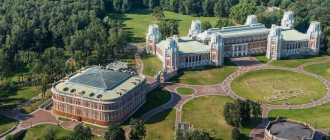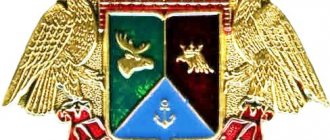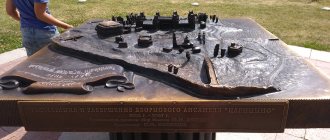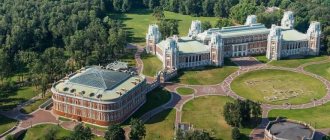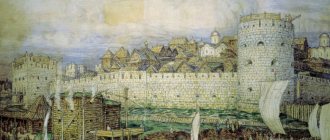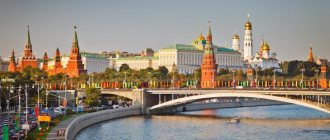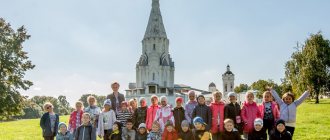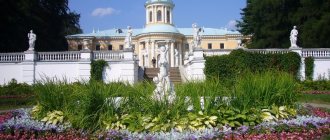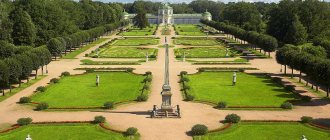The majestic building of the Grand Palace occupies the main place in the central part of the Tsaritsyno estate. The fate of the building is very complicated - the palace, the construction of which began more than two hundred years ago, was completed only in 2007. The Grand Palace is the drama and mystery of Tsaritsyno Park.
The unique structure, erected in 1775 by the outstanding architect Bazhenov, was destroyed by order of Catherine II. A tragedy occurred not only for the fate of the great architect and his entire life, but also for the entire history of the complex and Russian architecture.
The new building was rebuilt by the architect Mikhail Kazakov, but he also failed to complete the work. Only in 2007, after a two-year reconstruction, the estate appeared before Muscovites and guests of the capital in its elegant, magnificent appearance. This is one of the main park attractions of Moscow, which we recommend to all guests of the capital to visit, especially in the summer.
Grand Palace - brief description
The Grand Palace is interesting because its architecture combines two styles - pseudo-Gothic and classicism. The building consists of two wings, intended for the Empress and her son Paul. From the outside, the central part of the palace looks especially impressive, but you can see that in plan it is only a transition from one wing to another.
The uniqueness of the building is given by the graceful turrets, made in the pseudo-Gothic style. Note the rectangular windows framed by pointed arches, also related to this architectural style.
The red color of the walls with snow-white trim and fabulous turrets make the ensemble somewhat similar to the Kremlin Palace.
Due to the extended facades (the length of the building is 68 fathoms, or 146 meters), the building looks fundamental, and the presence of towers and numerous arches give it a powerful and even ponderous appearance.
To view this grandiose structure, you need to enter the arch between the Great Palace and the Bread House. You will see a glass pavilion, entering which you can go down an escalator and enter the lobby of the Grand Palace. There are ticket offices, souvenir kiosks and a buffet here. An exhibition of portraits of figures involved in the fate of Tsaritsyno and the Grand Palace is presented.
Silver Pantry
The Tsaritsyno Grand Palace offers its visitors a thematic exhibition of artistic silverware from the turn of the 19th - 20th centuries. The works were made by masters of Russian factories and artels of famous jewelers Faberge, Ovchinnikov, Khlebnikov and others. The exhibition is located next to the archaeological one, in similar interiors.
Showcases of different sections and heights contain single items or groups of them - sets, sets, sets. There are products in which famous brush and chisel masters are involved. Such is a vase in the shape of a swan, made based on Vrubel, an enamel insert with an image of the Swan Princess based on a sketch by the artist himself.
Many visitors pay attention to the large crystal bowl with a stand in the form of a silver rotunda. A very attractive combination of materials, using achievements of a related art form.
The vessel for the main Russian delicacy, Rak caviar, was made of silver and crystal at the Lorier company before the revolutionary events. The elaboration of the arthropod, which accurately conveys its structure, is admirable.
Caviar spoons for arranging caviar into portions were made at the Faberge factory. There were also vodka glasses of the original type.
The Pimen writing set, named after the hero of Pushkin's tragedy Boris Godunov, is elegant and at the same time modest. Decorative ornamental stone of discreet colors goes well with silver details. The explanation states that the set was made by Moscow artel No. 14, which for most visitors, as well as for us, means nothing.
First floor
The halls on the first floor are dedicated to the history of the estate. You will learn how it was built and what the Grand Palace was like at the beginning of the 21st century (in the hall there is a model of the palace before reconstruction).
An interesting exhibition of bronze busts of Russian grand dukes, tsars and emperors. The figures were cast in St. Petersburg in the 19th century at the factory of Felix Chopin.
Also on the ground floor there is a permanent exhibition “The Old and New of Tsaritsyno”. Fragments of the brickwork of the building walls are presented, including part of the first Bazhenov foundation and a fragment of the foundation of the Palace designed by Kazakov.
Having passed the main entrance and the beautiful staircase, we will enter the most luxurious hall of the Palace - Catherine's Hall. A sculpture of the Russian Empress, 2 meters 64 cm high, is installed here.
Painted parquet and mirrors in gilded frames, bronze and onyx trim, marble and gilding, crystal chandeliers and sconces - all this cannot but delight. Here you can admire small details (for example, door handles in the shape of lions' heads) and interesting ceiling designs and parquet patterns.
In the following halls there is a permanent exhibition “Catherine II. The Golden Age of the Russian Empire,” telling about the life and family of the Empress.
Temporary exhibitions
The Tsaritsyno Grand Palace has a decent surplus of exhibition space, which makes it possible to organize additional exhibitions. They happen here regularly, sometimes attracting no less spectators than the permanent exhibitions of the museum-reserve.
The premises reserved for thematic exhibitions, author's exhibitions and other formats are decorated without any thematic connection. The originality of the interiors is given by the direct organizers of the events through temporary means of expression.
Without trying to guess the themes of temporary exhibitions that were not included in our program, we acknowledge some successes in design. A standard interior can be enlivened both by the arrangement and hanging of exhibits and by lighting effects.
Despite all the criticality of the reviews of connoisseurs of historical authenticity, who completely deny the artistic and other merits of the restored structure, I do not want to agree with them. Well, the monarch never set foot here, but still the Grand Palace of Tsaritsyno is associated with Catherine’s era and her personality, and the controversial history of the building.
Pages 3 of 3 Previous3
Tags: architecturepalacehistoryMoscowRussiaestateschool excursions
Second floor
On the second floor there is a magnificent Tauride Hall, decorated with works of painting and sculpture. On one side of the hall there are busts of prominent people of the era of Catherine II, and on the other - sculptural portraits of members of the imperial family. Here you can take pictures in 18th century costumes.
The following halls display paintings depicting the emperors of the Russian Empire, from Paul I to Nicholas II, as well as tapestries (the exhibition includes both 18th-century tapestries and modern works).
Tauride Hall
The corridor leading to the second main hall, the Tauride Hall, is also decorated with palace chic. Only the flooring is simpler, but the doorway is particularly elegant. A minimum of gilding of protruding parts achieves the impression of beauty and moderation.
Cleverly chosen places for mirrors ensure reflection of wall lamps and ceiling chandeliers. Small inserts of picturesque miniatures above the aisles look great, as do the convex paintings located above. Additionally, the corridor is decorated with sculptures and paintings.
The columns in the Tauride Hall, although they have a base, can more likely be classified as Doric based on their capitals. There is less gilding on them than in Ekaterininsky, and the height of the pillars is less due to the lower ceiling. Even the floor lamps are smaller, although the number of horns is significant.
A mannequin with a Catherine era uniform, displayed near one of the doors, marks the changing room. The Tsaritsyno Grand Palace offers an unusual service here - rental of costumes from the Catherine era for photographing.
In general, the interior of the Tauride Hall is almost imperceptible, but more modest than the Catherine Hall. In addition to the differences already listed, several equally significant ones can be identified regarding the design style and its execution. However, this does not interfere with the successful conduct of photo sessions by disguised visitors.
The ceiling here, although painted, is flat, without arches or relief details. More modest, in our opinion. Looks like a flooring pattern. The Tauride Hall is decorated with portraits of Russian emperors, the central picture depicts, of course, Catherine the Great, accompanied by the conqueror of Crimea (Tavrida, as the peninsula was called then), His Holiness Prince Potemkin.
The appearance of the atrium
The atrium turned the Bread House into something more than an architectural monument of federal significance, which opponents of the new roof trumped. Decorated with ornamental plants and equipped with comfortable seating, the courtyard has become a good place to relax. The presence of lighting equipment indicates the holding of concerts and performances with lighting effects.
It can be seen from the photographs above that those who visited the Bread House carefully examine the unusual structure. Not only the transparent ceiling and brick walls with window openings are beautiful here, but also the patterned floor covering. A large red curtain and a real concert grand piano clearly indicate the cultural orientation of the building.
Regardless of the purpose of visiting the Bread House, be it a long tour of the entire Tsaritsyno estate or a targeted trip to a concert, anyone will enjoy being in the atrium. Even the photo reliably demonstrates the relaxed behavior of visitors. Once again you are convinced of the correctness of the architectural solution for a transparent roof.
Let the portable, but skillfully made organ by German craftsmen significantly expand the possibilities of performing special organ works. It is rare where you can hear the sound of an ancient instrument, except in individual cathedrals. Here you can listen, along with church music, to secular musical works that sound completely unusual with the participation of an organ.
Opening hours in Tsaritsyno
The park of the museum-reserve is open daily from 06.00 to 24.00. If you plan to visit individual objects, for example, a palace or greenhouses, then you should take into account their opening hours. The greenhouses are open on weekdays from 10.00 to 18.00, on Saturday from 10.00 to 20.00, on Sunday from 10.00 to 19.00. Monday and Tuesday are days off in greenhouses.
The palace is open on weekdays from 10.00 to 18.00, on Saturday from 10.00 to 20.00, on Sunday from 10.00 to 19.00. Monday is a day off. At the moment, exhibitions in the Grand Palace and the Bread House, the Opera House, and the Third Cavalry Corps are open for inspection. You can purchase entrance tickets in the covered pavilion at the entrance to the palace or on the official website of the museum.
On the shore of the pond, Tsaritsino
Queen's Wrath and Mercy
Vasily Bazhenov was born into the family of a deacon of one of the Moscow court churches. Since childhood, the boy showed talent as an artist and was noticed by the architect Dmitry Ukhtomsky, who took him on as a student. Later he received an excellent education: he was among the first students of the Academy of Arts established in St. Petersburg, and one of the first to be sent by the academy to study in Paris. Upon returning to Russia, he was treated kindly by the empress and began developing his main project - the Kremlin Palace. The project surpassed everything that was created in Europe at that time - both in grandeur and unprecedented courage. A groundbreaking ceremony for the palace took place, a design model was created, but things did not go further than that.
In 1775, the architect was entrusted with the construction of festive pavilions on the Khodynskoye field, where a celebration was to take place on the occasion of the conclusion of the Kuchuk-Kainardzhi peace in the Russian-Turkish war. Catherine II liked the buildings, and soon Bazhenov was entrusted with the construction of the palace ensemble in Tsaritsyn. The young architect was inspired by the idea of creating a new, special architecture, the likes of which Russia had never seen before.
Photo: Press service of Tsaritsyno Park / Dmitry Shchelokov
According to his idea, the Tsaritsyn estate was to become a single complex, in which the empress’s palace was also not the dominant feature. By 1785, the construction of the imperial residence was completed, only the interior decoration remained. Catherine II decided to familiarize herself with the progress of construction and arrived in Moscow. Arriving in Tsaritsyno, she examined the residence and the almost completed palaces and was indignant: the vaults seemed too heavy to her, the rooms too low, the boudoirs too cramped, the staircases too narrow. She decided that it was generally impossible to live in them. Bazhenov was removed from further construction, and the creation of a new project was entrusted to his student, Matvey Kazakov, which especially hurt the architect. There are many versions of why Catherine did not like the palace. According to one of them, the architect’s intrigues and Masonic connections were to blame; according to the other, Bazhenov’s rebellious disposition and the fact that he constantly went beyond the budget.
Photo: Press service of Tsaritsyno Park / Dmitry Shchelokov
How to get to Tsaritsino
The museum-reserve has several entrances; you should choose the one that is closer to the attractions of interest to you. If you want to take a walk in the park area and around the pond, then you should get off at the Tsaritsyno metro station and walk towards the main (central) entrance. If you want to first get to the palace and other buildings near the palace (the Bread House or greenhouses, for example), then it makes sense to get off at the Orekhovo metro station and go to the palace through forest alleys. Along the way, by the way, you can meet and feed squirrels; there are quite a lot of them in Tsaritsyno Park. The exact address of the museum-reserve: st. Dolskaya, 1.
Palace in Tsaritsyno
Description of the museum complex
The museum-reserve, which occupies more than 100 hectares, is located in the south of Moscow. Its history began in 1776, when Catherine ordered the construction of a residence. In the 19th century The area turned into a holiday village. In 1927, a museum was opened here, and after the war, protected lands with an area of 1000 hectares were allocated. Later, 2 large-scale restorations took place in Tsaritsino. In 2007, the updated architectural complex opened on Moscow Day.
The complex layout includes the following structures:
- Great and Small Palaces;
- Cavalry Corps;
- Bread House;
- Opera House;
- greenhouses;
- Temple of the Icon of the Mother of God “Life-Giving Source”.
The estate was built on a cape, so the Figurny and Bolshoy bridges were built on the territory. The latter is decorated with rosettes, a zigzag belt under the cornice, and inserts in the form of diamonds and circles. The central arches are reminiscent of portals in Gothic cathedrals. The figured bridge, which is decorated with St. George's crosses, was built on the principle of a viaduct. A high parapet with lancet openings connects the semicircular towers.
Greenhouses
One of the Tsaritsyn greenhouses.
The first wooden building appeared in the 1740s, when the estate belonged to the Kantemirov family. At the end of the 18th century. there were 3 buildings here, where up to 10,000 trees were grown. There were greenhouses with pineapples, oranges, oranges, grapes and peaches. Myrtle, olive trees, apricots, oleander, laurel and park flowers grew in the premises. There was a large collection of tropical plants in Tsaritsino.
After the death of the Empress, the work of the greenhouse was supported by the head of the Kremlin Building Expedition P. Valuev. 8 premises are being built on the territory. In the 19th century the complex is rented out to the merchant Davydov. Later, the old buildings are demolished, and the grape greenhouse is divided into communal apartments.
The buildings began to be restored in 2008 according to old drawings.
3 buildings are open for tours. The first building features hibiscus, fuchsia, araucaria and palm trees. In the second room, vegetables, fruits, rosemary, oleander, myrtle, ginger, and coffee trees are grown. Cacti and ornamental plants grow in the grape greenhouse.
Famous fountain
The famous musical fountain.
Modernity in the estate is represented by a musical fountain. It was created during the reconstruction of 2006-2007. on the Lower Pond. According to legend, in this place in 1775, Prince G. Potemkin organized a salute for Catherine II, which was accompanied by a salvo from captured Turkish cannons. The bowl-shaped structure covers 2,400 m², illuminated by 2,583 underwater lights. Its diameter is 52 m.
Along with the fountain, the Grand Palace and the bridge over the ravine are illuminated. 915 jets rise up to a maximum of 15 m to the beat of the music.
The soundtrack includes 60 classical pieces.
It is equipped with an acoustic installation, so the compositions can be heard from any shore. Due to sensitivity to low temperatures, the fountain is preserved after the end of the season.
Grand Palace and Bread House
The Grand Palace combines elements of Russian Gothic and classical style.
The Tsaritsyn Palace combines elements of Russian Gothic and classical style. At first, the construction was carried out by the architect V. Bazhenov. After inspecting the building in 1785, the Empress entrusted the work to his student M. Kazakov. The building includes 2 wings, which were intended for the residence of the empress and her son Paul. They are connected by a narrow high gallery. The palace is decorated with lancet windows, pointed towers, semi-columns and arches. In 1796, it was almost completed, but the death of the empress stopped the process.
In the 19th century the area was used for recreation. Thanks to the reconstruction of 2005-2007. the complex was restored to its original appearance.
The Catherine Hall was created in the right wing on the first floor. It is decorated with valuable trees, gold, onyx columns, and stucco. There is a marble statue of the empress, 2.6 m high, installed here. The second room with cherry walls and marble columns was called the Tauride Hall. On the 3rd floor there are the Bazhenovsky and Kazakovsky halls, which are connected by an enfilade. The building hosts celebrations, exhibitions and concerts.
Near the palace is the Bread House, where the kitchen for Catherine II was located. The square-shaped structure with rounded corners was built in 1784-1785. On the facade there are 2 high reliefs in the form of a salt shaker with a loaf. Above the cornice are the letters X and C (bread and salt). An interesting fact is that the X appears in the form of crossed lines, which are considered a symbol of Freemasonry. Visually, the house and the palace are connected by a gallery, which is interrupted in the center by an arch with spikes. The building houses the main exhibition of the museum; concerts and theatrical performances are held in the atrium.
Contacts and cost of visiting
Entrance pavilion to the Tsaritsyno State Museum.
For pre-registration call +7(495)322-44-33. The cost of a comprehensive ticket to view the palace ensemble is 890 rubles. From 100 to 400 rubles. It is worth visiting one building of the complex.
The museum provides discounts to students, pensioners, disabled people of group III, members of large families and children under 18 years of age. They pay 370 rubles for a comprehensive ticket. To inspect individual structures you will need 80-110 rubles.
Free entry is provided for the following citizens:
- children under 7 years old;
- heroes of the Russian Federation and the USSR;
- veterans of the Great Patriotic War;
- disabled people of groups I, II;
- awarded the medal “Resident of the besieged Stalingrad”;
- orphans;
- military personnel;
- workers of museums of the Russian Federation;
- ISIC card holders.
On every third Wednesday of the month, people are admitted for free. For a tour of the Grand Palace or the Bread House you pay 150 rubles. A walk through one greenhouse and palace grounds will cost 225 rubles.
Inspection as part of a group costs 200-1000 rubles. depending on the number of people and location.
Every year the museum hosts the “Night of the Arts” event. Entrance is free after 18.00. Guests can attend exhibitions, plays, concerts and performances.
Rules for visitors
To travel to the landscape museum-reserve, you must adhere to the dress code. You cannot enter in outerwear, beach clothes with large backpacks and bags. Strollers, roller skates, pets and food are not allowed.
The following activities are prohibited on the premises:
- smoke;
- bring alcohol and any drinks in glass containers;
- light a fire and pitch a tent;
- make a picnic;
- throw away industrial and household waste;
- spoil trees and collect plants;
- walk on lawns and flower beds;
- swim in ponds and fish;
- walking pets;
- carry weapons and explosives;
- draw on the walls of buildings and monuments;
- Posting flyers.
Only preschool children are allowed to ride a bicycle, rollerblades, or scooter in Tsaritsino.
Children under 6 years old must be accompanied by adults.
Events, excursions, professional video or photography are carried out after agreement with the museum management.
“Cursed Land”: What the Tsaritsyno Museum-Reserve is hiding
“Unsolved Mysteries”: “Tsaritsino”
Tsaritsyno. Why are there so many myths and legends about this place, and is there a mystical meaning in the history of the Tsaritsyn Palace? And how is the personal tragedy of the architect Bazhenov connected with the funeral feasts of the ancient Vyatichi, whose mounds still tower over the park ponds in Tsaritsyno? The Moscow Trust TV channel prepared a special report.
Cursed land
Moscow metro workers still remember January 1, 1985 as a bad dream. 7 a.m. The train rushes through the tunnel to the newly opened Lenino metro station in the south of the capital.
When the train reaches maximum speed, right before the driver’s eyes, a huge fragment of the lining breaks off from the tunnel wall, followed by water gushing out. “Tsaritsyn Pond,” the driver managed to think.
Similar accidents were repeated in April 2001, in November 2003, and in 2011 there was a fire in the area running under Tsaritsyno Park. For most Muscovites, all this is just part of life in a big city, where something constantly breaks or burns. Researchers of anomalous phenomena think differently. In their opinion, the Tsaritsyno Museum-Reserve is a place with a special energy that often adversely affects the course of events.
“Scorched earth, damned. Therefore, it is, as they say, unfavorable to erect buildings,” says dowsing specialist Anatoly Shmulsky. Despite this, Tsaritsyno invariably attracts unusual and even strange people - rock climbers, Tolkienists, hippies and even Moscow pagans. And they feel great on this earth.
Photo: m24.ru/Alexander Avilov
Anatoly Shmulsky is a specialist in dowsing, a technology that allows one to determine the presence of objects or energies using special devices. Now Anatoly is working on creating a map of geopathogenic zones of the Tsaritsyno palace and park complex. The work begins with an examination of the main Tsaritsyn attraction - the Grand Palace.
“The geopathogenic zone starts from here. An area unfavorable for long-term living. Although this is a favorite place for townspeople. I like it here myself. However, it is, of course, unfavorable for long-term spending time here,” says Anatoly Shmulsky.
This place has long attracted researchers of all kinds of anomalies. In 1993, geologists from the Russian Academy of Sciences, after conducting a large series of studies, came to the conclusion that almost the entire territory of the Tsaritsyno Park is a geopathogenic zone - this is the name given to areas of terrain where various phenomena are regularly observed - usually of a negative nature. They are detected using complex instruments, but Anatoly uses the simplest and, in his opinion, the most reliable - frames.
“I don’t really feel anything that my fine motor skills are responding to. It all depends on the professionalism of the operator. At some point, either something begins to happen to the frames, they unwind, or they cross, and it is impossible to unclench them. No matter how much you check, they still close,” says Anatoly Shmulsky.
An average person looking into the park for a walk on a summer morning most likely will not notice anything special. However, the employees of the Tsaritsyno Museum, who spend much more time here, confidently say: the main feature of this place is that nothing can be planned here. No matter what you expect, your workday will be full of surprises.
“Actually, I’m not a mystic, I’m a completely sane person. But I can probably confirm that this is a mystical place. You almost never know what awaits you when you arrive here. This is the unpredictability of the scenario according to which events unfold here,” says Sergei Leonov, head of the department for registration and protection of cultural heritage objects of the Tsaritsyno State Museum.
From dirt to Kings
The area received its current name in the 18th century. Before this, the village of Bogorodskoye was located here, which belonged to Boris Godunov’s sister Irina. During the Polish occupation the village burned down. The resulting wasteland, without thinking twice, was called Black Mud.
The surrounding area was owned by the boyars Streshnevs, then the Golitsyns. In 1712, Peter I granted these lands to the former Moldavian ruler, Prince Dmitry Cantemir, as a gift for allied assistance in the war with the Turks and compensation for the lost throne.
Catherine II drew attention to the area with a not very romantic name in 1775 during a horseback ride around the outskirts of Kolomenskoye, the then royal summer residence.
“From Kolomenskoye, an ancient royal place with a very beautiful wooden palace, she went on horseback for a walk around the surrounding area. And when she drove up here, to Tsareborisovsky Pond and this property, she was shocked by the very beautiful nature,” says local historian Irina Levina.
Photo: m24.ru/Yulia Nakoshnaya
The Empress did not like Kolomenskoye. The dilapidated wooden palace seemed to her an anachronism, inappropriate for her crowned status.
But it was decided to build a new summer residence in this picturesque place, the owner of which at that time was the son of Dmitry Cantemir, Sergei - according to the recollections of contemporaries, an old man of about 70, who did nothing but play cards and scold when he lost.
“All her subjects immediately rushed to find out from Kantemir: he wants to sell this Black Dirt, he does not want to sell this Black Dirt. It seems like we agreed on the amount of 20 thousand rubles. But Ekaterina said that “no, 20 thousand rubles is not enough. I will give 25 thousand rubles for it. Literally 3 weeks later the deed of sale was already completed for 25 thousand rubles,” says Irina Levina.
Knight fights two centuries later
Catherine commissioned her favorite architect Vasily Bazhenov to build a new summer palace. The great architect could not even imagine then that the main work of his life would turn into the most bitter tragedy. And he set to work eagerly.
Within a couple of months, a small wooden palace arose on the Black Gryaz wasteland. That same summer, the Empress herself visited him in company with her faithful companion, Prince Grigory Potemkin.
“The queen was placed in a pavilion, from which she observed the solemn haymaking festival. They dressed the Moldavian mowers in red blouses and hats with peacock feathers. They mowed, the girls collected the hay with songs. And among the mowers, Prince Potemkin stood out,” says Irina Levina.
It is noteworthy that the penchant for dressing up and other role-playing games was revived in Tsaritsino two centuries later. At the end of the 90s of the last century, at the famous Tsaritsyn ruins, lovers of sword fighting were sorting out their attitude.
“In the 90s there was not a single section where you could come and say: “I want to feel like a knight, I want to pick up a sword, I want to learn how to fight like an ancestor.” There were some reenactors there, but they were completely frostbitten guys. They fought with iron, they beat each other. Strongly. Hurt. And then they told me that: “You like to fight with swords. But there is a place in Moscow where guys gather and just fight with swords.” I said: “Wow, I want it!” recalls Tolkienist Vladimir May.
The Tsaritsyn knights with wooden swords were one of the factions of the then powerful Tolkienist movement. However, the language of the elves and the traditions of the hobbits were not studied at the Tsaritsyn ruins.
People came here exclusively to fight. According to the rules, one touch of the sword deprived the player of his life. By the end of the fight, a lot of “killed” had accumulated. Therefore, Tolkienists nicknamed Tsaritsyn Castle Mendes - the hall of the dead.
“The Hall of the Dead was the name given to the central hall in the castle, where people who were killed during gatherings came. They came there and rested. And the name of the central hall gave the name to the whole place, the gathering,” says Vladimir May.
Today Vladimir May works as a welder, and in his free time he teaches sword fighting to those who wish to do so. Occasionally he visits Tsaritsyno, and invariably with a weapon. What if you meet someone with whom you are destined to cross swords?
The tragedy of the architect and Masonic signs
Vasily Bazhenov, as a real state councilor and, therefore, a nobleman, was also entitled to a sword. However, this accessory does not appear in any of the surviving ceremonial portraits. An architect is generally a peaceful and unhurried profession. The construction of the complex of buildings of the new imperial residence took him more than 10 years. It was here that the style that would later be called “Russian Gothic” was born.
“The style that was there was conceived by Bazhenov. And basically he remained embodied in the bread house, and more in those famous bridges of his. This, of course, is a unique phenomenon for Russian architecture as a whole,” says architect Mikhail Posokhin.
Photo: m24.ru/Mikhail Sipko
Construction required a lot of money. Bazhenov often went beyond the budget, and he had to spend his own money. Due to financial problems, the architect's wife's estate and house in Moscow had to be sold. So the Bazhenovs moved to a government house in Tsaritsyno. And when the palace was almost completed, the customer, Empress Catherine the Great, came to inspect it.
“She was supposed to arrive in July, but she arrived at the very beginning of June. And I came here not from the front side, not from the one from which Bazhenov built his views, but from the back, where the nature is not so beautiful, not everything is ready yet. She didn't like it. And in general, she wrote in a letter to Grim that the halls are very small, the ceilings are low and overhanging. It seemed to her that this structure looked like a coffin,” says Irina Levina.
Catherine, as you know, was very unrestrained in her tongue. However, many historians argue that there was some truth in her words. For Bazhenov, external beauty and harmony were important in architecture. Convenience and comfort, on the contrary, are secondary.
According to legend, when examining the palace, Catherine did not find a single toilet. The result of the inspection was simply stunning: Catherine ordered the residence to be dismantled to the ground and a new building erected. The case is unprecedented.
No ruler has ever allowed himself such extravagance - to destroy a completely rebuilt palace. The reasons for such a strange act of the empress still remain a topic for heated debate. One of the most popular versions says that Catherine was confused by the abundance of Masonic signs in the decor of the palace complex.
“Stars are also Masonic signs. You can see Masonic signs on the walls, and on the towers, and on the arcades - there are suns between them,” explains Levina.
However, the symbolism of the “free masons” society itself could hardly have become the root cause of such a radical decision by the empress. Perhaps the point was that the architect himself was a member of the Masonic lodge, and by no means in the last roles.
“Belonging to Freemasonry was not somehow criminal in the period of Catherine. And moreover, it was essentially her associates who formed these Masonic lodges. A conflict could arise when a large number of Freemasons began to pose a certain threat due to their commitment to the interests of the heir - the future Emperor Paul I. This could have caused some kind of disapproval from Ekaterina,” says Sergei Leonov.
“She developed some kind of suspicion at this time. Maybe it has an effect... she is already 56 years old - such a critical age for women. She saw conspiracies everywhere,” says Irina Levina.
Be that as it may, the construction of the new palace was entrusted to Matvey Kazakov, Bazhenov’s student. For the former court architect, this was a real tragedy. 10 years of hard work, dreams of a palace that would glorify him for centuries, turned into collapse and professional demotion.
“Bazhenov suffered here for 10 years. I was trying to build something. He already had a family here, as far as I remember. Neither his career here nor his life went any further. Nothing went well. Indeed, the place is anomalous,” says Anatoly Shmulsky.
Photo: m24.ru/Evgenia Smolyanskaya
However, an unenviable fate awaited the creation of Matvey Kazakov. The palace was not yet completed when the “contractor” died. But for some reason Paul I, who ascended the Russian throne, was not interested in the project. The estate gradually fell into disrepair.
“It belonged to the Moscow Palace Office, which was always short of money. The Moscow palace office - it contained the Kremlin palaces and palaces belonging to the tsar, including the huge, huge estate of Tsaritsyno,” says Irina Levina.
Soviet hippies
In 1803, Alexander I opened Tsaritsino for Muscovites' summer country festivities. And a few decades later, construction of dachas began near the palace complex. The area, which seemed unsuitable for residence to the reigning persons, was gradually populated by Moscow officials, as well as by the creative intelligentsia (memories of the same Bunin, who it was here - in the wonderful places of Tsaritsyno - that he met the niece of Sergei Andreevich Muromtsev, Vera Nikolaevna Muromtseva - in 1906 she became his common-law wife).
And after the revolution, the proletariat settled in Tsaritsyn. Communal apartments were established in the bread house - a little more than 30 meters per family. Stove heating, amenities in the yard, you have to go to a water pump to get water - the conditions are far from royal. Of course, no one had heard of geopathogenic zones then.
Whether any special cataclysms happened on this particular piece of land, history is silent. But it is known that very close by were the vegetable gardens of the inhabitants of the Tsaritsyn communal apartments - right in the large clearing behind the palace. In the hungry post-war years, they helped the local residents feed and survive.
“Now this is a very well-maintained park that has emerged in the last 20 years. Before that it was a pretty abandoned place. Until 1960, this was generally the Moscow region, and therefore everyone who lived fed from the land. But here there is a lot of it, and you can make a lot of vegetable gardens here,” says Irina Levina. Communal apartments were resettled only in the 70s of the last century. And now the clearing where potatoes and cabbage once grew is one of the favorite vacation spots of Muscovites. Here you can forget about the bustle of the big city, take off your shoes, and walk on the grass.
You can guess that everything is in order with the energy here without special instruments. Every year, flower children welcome and see off summer in a large meadow. Hippies began gathering in Tsaritsino about 30 years ago. They were attracted not so much by ancient architecture as by nature. It was also relatively safe here.
“In Moscow they screwed up. There were also screws here, by the way. Here they gathered us into five sections. It was 1982, I think, or 1980. But you can find out about this in the KGB archives,” recalls Sergei Solmi.
Artist, poet and musician Sergei Solmi is one of the patriarchs of Moscow hippies. By tradition, he unobtrusively promotes world peace and universal love. Dreadlocks, beads, colorful robes of all genders and ages. For many, this holiday is an opportunity to find unity with nature without leaving the metropolis.
Photo: m24.ru
“Some people wear white collars, but here they are already having fun. And I, since I’m a street musician, that’s how my life is. I'm just glad that good people come. I like that there is a forest here, that it is clean, that there are no cars nearby,” says street musician Mikhail Veter.
No matter how strange people in bright clothes and with exotic musical instruments may look against the background of an old neo-Gothic palace of the late 18th century, they are welcome guests here.
For decades, Tsaritsino was a place where all kinds of people gathered. These were Freemasons, Tolkienists, hippies, volleyball players and chess players. Our palace, our park is a place where memories are preserved that everyone should love. If they love hippies and gather here, then what’s wrong with that?” - says the director of the Tsaritsyno State Museum Natalya Samoilenko.
Climbers on the Devil's Staircase
Another unusual place in Tsaritsyn Park is a tower called Ruina. It was erected at the beginning of the 19th century, when fancy structures imitating ancient ruins were in fashion. Such buildings were supposed to encourage romantic people to philosophical reflection.
The frames in the hands of the dowsing specialist near the Ruin did not tremble, which means that this place is quite safe. Indeed, no major tragedies happened here, although by the end of the 19th century the steps were crumbling, and drunken revelers fell from them with enviable frequency. Therefore, the Ruin began to be called the “Devil's Staircase”. A few decades later, the “Devil's Staircase” was chosen by Moscow climbers.
“They were climbing here... in general, the whole of Moscow was climbing. It was not for nothing that the Empress invested a lot of money, and it turned out to be a good climbing wall, which was used by many generations of Moscow and Soviet climbers in general,” says sports climbing veteran Leonid Mach.
Beginning climbers first conquered this tower. It is not as complex as other Tsaritsyno buildings.
“There were no climbing shoes back then; we climbed in galoshes. These were Asian pointed galoshes. It was the most chic. There were no better climbing shoes. Foreigners said: “This is the secret weapon of the Russians,” says master of sports in mountaineering Vladimir Kolomytsev.
After conquering the Ruins, it was possible to go to more difficult objects - the walls of the Grand Palace. For almost 60 years, from the 1930s to the 90s, the Tsaritsyn ruins were the main training ground for Soviet rock climbers.
“We climbed the façade of the castle absolutely everywhere. There is probably no stone where a human hand, the hand of a rock climber, has not touched. One of my favorite moves was the column. They climbed here, there, and took into the column...., their feet in these gutters, and their hands on the recline. We held our hands between the stones, so that if, God forbid, one stone did not fly out, the other remained and held on,” explains Leonid Mach.
Many at the Tsaritsyn ruins behaved as if in real mountains. They made small expeditions to the top of the palace.
Photo: m24.ru/Yulia Nakoshnaya
“Our senior comrade Anatoly Barovsky worked at the plant. Came over on Friday after work. There was a sleeping bag somewhere on a shelf, hidden high up. I climbed, ate there, trained, and slept on a shelf at night, like in the mountains,” says Mach.
Climbers became part of the history of Tsaritsino. And now the museum is planning to dedicate a separate section of the exhibition to them.
“When I was a student and for the first time saw how strong young people were climbing the magnificent ruins of Bazhenov and Kazakov, I was horrified. They seemed to me to be the most important enemies,” says Natalya Samoilenko.
Now, however, these people swear and swear that they did not hammer in any pegs, and only the strength of their hands helped them climb these walls. The museum-reserve turns 30 this year. And I think that in connection with the anniversary of the museum-reserve, we will hold a series of meetings that will allow us to restore in many ways this living human personal history of the museum.
Polishing the Kozakov walls with their palms, the climbers never forgot that they were using one of the most mysterious palaces in the city as a training ground.
“Any stone is a certain structure that carries information. Here is a modern climbing wall - they made it out of plastic, fiberglass. There he knocked - zero information. When we touch either a rock, or a stone, or something, or any object, and when you are in contact with it for a long time, you begin to feel it, and somehow read in the subconscious the information that is in it,” says Leonid Much
Time of Troubles Tsaritsino
By the beginning of the 2000s, fans of sword fighting stopped gathering in Tsaritsyn. The climbers also disappeared. And the palace itself turned from romantic ruins into an unpleasant place. The walls are covered in writing. There is garbage everywhere.
“The diagnosis is very simple: 5 years – and an open field. Like a pile of bricks after 5 years. That's it, it's over. For this building, for the Grand Palace,” says architect Mikhail Posokhin.
It became clear: in order to save at least something, we had to act. Either conserve and protect the ruins, or reconstruct the building. It turned out to be almost impossible to preserve ancient stones in our climate. That's why we decided to build. Many Muscovites were not happy about this news.
“The palace was such a very picturesque ruin. Trees grew from it. From such thickets, especially when you come from the other side, from Orekhovo, such mysterious ruins rise. It was probably the most mysterious place in Moscow,” says Irina Levina.
However, some of the old palace still remains. Archaeologists have documented inscriptions that appeared layer after layer on the walls over decades. Most of them were not original. But even the standard “Sasha + Masha” or “Vasya was here”, it turns out, are of a certain value for scientists, because they reflect the spirit of the times.
Photo: m24.ru/Alexander Avilov
“We recorded all these inscriptions before the restoration. Despite the fact that many of them were relatively recent, the 80s, in my opinion, were the latest in the 20th century. It's still interesting. These were the most interesting inscriptions from the war, I would say. There are all sorts of them, some patriotic and some not so patriotic. But, in general, such lively and very good voices of people talk to us,” says archaeologist Leonid Belyaev.
“I will have a memory for the rest of my life: it’s unclear how, it’s unclear why, it’s unclear who did this in the central hall of the castle - at the top there was a huge beautiful inscription “Aragorn is a fool.” Aragorn is one of the key characters from The Lord of the Rings,” says Vladimir May.
In 2007, by order of Mayor Luzhkov, architect Mikhail Posokhin began building a new, actually third, Tsarininsky Palace.
“Well, for me it was an amazing event that has accompanied me throughout my creative life. My dad and I, when I was 7-8 years old there, I went there all the time. He drew. I made watercolors of these Bazhenov bridges. I was also somehow present there,” he noted.
At that time, only the walls remained of the large palace. Everything else - floors, interior spaces, roof - had to be built anew. The design of the new palace was in many ways different from what it was under Kazakov and Bazhenov. This became a source of controversy. Was the construction the salvation or the final destruction of the architectural monument? The founder of the Arkhnadzor organization, Rustam Rakhmatullin, believes that the new palace is a fatal mistake.
“When Luzhkov proposed covering the facades built according to the second version of the project with roofs taken from the first, it was absolutely unscientific. The result is obvious. This overload of the Kazakovsky Palace with pomp is completely unacceptable. So maybe it’s worth treating this decision as reversible? The same applies to covering the courtyard of the Bread House. All this one day, I think, will need to be sorted out,” Rakhmatullin shared his opinion.
However, Mikhail Posokhin himself does not pay attention to criticism. He is proud of his work, and considers all attacks to be insignificant quibbles. “Everything that could be preserved there was preserved in detail. But let's say a balcony. Previously, we went out onto the balcony, and the fence was knee-deep. Today, according to standards, it should be 1.1 m. But this seems like a trifle for conversation, but in reality it is a terrible task, because you must ensure the safety of a modern person, but at the same time not change the facade,” notes Posokhin.
Meanwhile, the new palace is already more than 5 years old. And even those who at one time accepted the remake with hostility, today, it seems, are no longer so categorical. “Many times in my memory it has happened that a person expresses his negative attitude, but after visiting Tsaritsyno, walking in the park, going into the palace, seeing the exhibition, he sharply, very sharply changes his attitude,” says the head of the accounting department and protection of cultural heritage objects of the Tsaritsyno State Museum Sergey Leonov.
“In fact, a lot of original things have been preserved in Tsaritsino. It is still an architectural monument of the 18th century. And here there are marvelous Bazhenov spaces. It has stunning magical Gothic architectural decor. Here, everything really merges with the magnificent terrain,” notes Natalya Samoilenko, director of the Tsaritsyno State Museum.
“When I came to Tsaritsino for the first time after reconstruction, I said: “Ugh, what have they done here? It was so great. It was possible to simply restore order and preserve all this romance.” Nothing, then I got used to it,” Tolkienist Vladimir May shares his impressions.
Mounds and pagan fires
Meanwhile, dowsing specialist Anatoly Shmulsky is heading deep into the park, to where the burial mounds of the Vyatichi, the ancient Slavic tribes that inhabited this area in the 11th-12th centuries, still rise.
“The first Slavic inhabitants of Moskvorechye buried their dead in mounds - in rather high mounds that were erected over the graves. The mounds in the Tsaritsyn Forest Park began to be studied back in the 19th century. Since then it has been one of the most famous archaeological sites in Moscow. In Soviet times, thousands of archeology students made their first finds at these excavations. How to teach a person to be an archaeologist? How to teach him to excavate ancient monuments? Probably, he should take part in these excavations, learn the technique, how to take a competent plan, how well photographs are taken, how to select objects so as not to damage them. This craft was taught to students until the 60s and 70s, in particular at Tsaritsyno,” says archaeologist Leonid Belyaev.
As a rule, students found fragments of jewelry and ceramics. The ancient Slavs went to the world of their ancestors fully armed: dressed up and with treats. And from the outside, the funeral looked more like a celebration. Before giving the body of the deceased to the fire, the Vyatichi performed a funeral feast - ritual festivities, feasts and military competitions in honor of the deceased.
Photo: m24.ru
“During burial, for example, wedding or, in any case, ceremonial attire is preserved for women. They were placed in graves with all the sand rings, necklaces, bracelets, rings. For men, burial was more modest. Usually they put some kind of tools, sometimes knives, something for their point, sometimes a sickle, a scythe or some kind of weapon,” notes Belyaev.
Despite the fact that the mounds have been studied for more than a century, it is possible that ancient burials will bring many more sensations. After all, some graves still remain untouched. “Among the Tsaritsyno mounds there is everything: there are unexcavated mounds, there are mounds that were looted in the past or half-excavated. But even such mounds contain information. Because in the 20th century they didn’t dig between the mounds, and there are monuments there too,” adds Belyaev.
It is noteworthy that pagans who follow the covenant of the Vyatichi can still be found in Tsaritsino today. “Vyatichi is, strictly speaking, one of the Slavic tribes. The people who once lived here defended this land and developed it. Probably, some part of the blood of these ancient ancestors of ours—the Vyatiche—flows in many of us,” says pagan Ilya Cherkasov, who also calls himself the sorcerer Veleslav.
In one clearing, for example, two worlds converge: the world of the living and the world of the dead. So, at least, modern pagans think. “At the junction of life and death there is something between worlds, something where both sides are open, and a person here has a different degree of freedom. That is, he breathes differently. He is open to both this and this world,” explains Cherkasov. Several years ago, the ancient Slavic temple found a second life. In June 1995, after regular excavations and arrangement of the mounds, modern admirers of the beliefs of their ancestors erected images of pagan gods here. Now in a clearing in the Tsaritsyn forest there are wooden Veles, Lada and Dazhdbog. These are already the third churas - that’s what the pagans call these wooden idols. The previous ones fell at the hands of vandals.
“Different people, based on different considerations: some out of religious fanaticism, some out of hooligan motives, came here to do some harm. Apparently it was difficult for them to pass by the beautiful statue without leaving their mark on it. Pagan faith, like any natural faith, not invented by people, but coming from nature itself, from existence itself, remains, and when our visible shrine is destroyed, for us this is only a reason to restore it, and not to be sad,” says Ilya Cherkasov .
Magus Veleslav, and according to his passport Ilya Cherkasov, as a rule, visits here alone. This temple is one of those where mass rituals are rarely held. People come here to understand themselves and ask questions to their ancestors.
“We are on a hill, it forces a person to open up to the sky and the sun. But, nevertheless, next to us are those very mounds of the Vyatichi people. That is, here life and death are intertwined. And for the Slavic temple this is a very important moment. The temple is a meeting of worlds, a meeting of the visible and the invisible, reality and reality. That is, here a person meets his ancestors, meets the gods who look at us from the invisible reality,” argues a modern pagan.
Major pagan holidays are not celebrated here. The Pagans have to put up with the park's rules. No fires are allowed on the territory of the museum-reserve. “Fire for us is a visible symbol of the presence of a deity, transforming forces in our world. Since, according to the laws of the park, it is impossible to light a fire here, a person can come himself with some kind of small candle or torch. That is, light a fire, then extinguish it so that there is no fire, and so on, and then calmly leave,” notes Cherkasov.
“The same energy is already coming here. Hundreds and hundreds of people are buried here, so these places could be the cause of all the anomalous geopathogenic phenomena,” says dowsing specialist Anatoly Shmulsky. In his opinion, it was the pagan bonfires, especially those on which the dead were burned, that became the cause of geopathogenic zones, anomalies and other hardships in Tsaritsyno.
Fires in these places did occur with depressing regularity. The almost completed Kazakov palace burned down under unclear circumstances. Outbuildings that housed various institutions burned almost every year. In February 2008, the greenhouse complex burned down. In January 2010 - a barracks built on the site of the dacha of the chairman of the first State Duma, and therefore, according to a long tradition, called “Muromtsev’s dacha.”
Photo: m24.ru
“This is due to pagan rituals that took place here repeatedly over many generations. These places burned repeatedly, because there was not only a stone building, but also a wooden one. Everything was burning here. It was always burning. Energy isn't going anywhere. At times, maybe a little weaker, a little stronger, but it doesn’t disappear,” notes Shmulsky. The only way to protect yourself from geopathogenic zones is to stay in them as little as possible. And certainly not to choose them as a permanent place of residence. Isn’t this what Catherine the Great felt two centuries ago by some miracle? However, dowsing experts say that you shouldn’t deprive yourself of walks in the picturesque park.
“Tsaritsyno” is not the most anomalous and not the most geopathogenic zone in Moscow. It's still average here. As for living here, yes, it is unfavorable. But just travel, take a walk - why not? It’s very cool,” adds Shmulsky.
Another geopathogenic zone is marked on the map. Are they really the cause of all Tsaritsino’s troubles? Or are local anomalies nothing more than just another urban legend? Be that as it may, Tsaritsyno is an example of the paradoxical history of an architectural object and the destinies of people. And also a place where everyone finds what they are looking for: some - the peace and beauty of nature, some - adventure, and some - the as yet unsolved mysteries of history.
Plot: City stories
